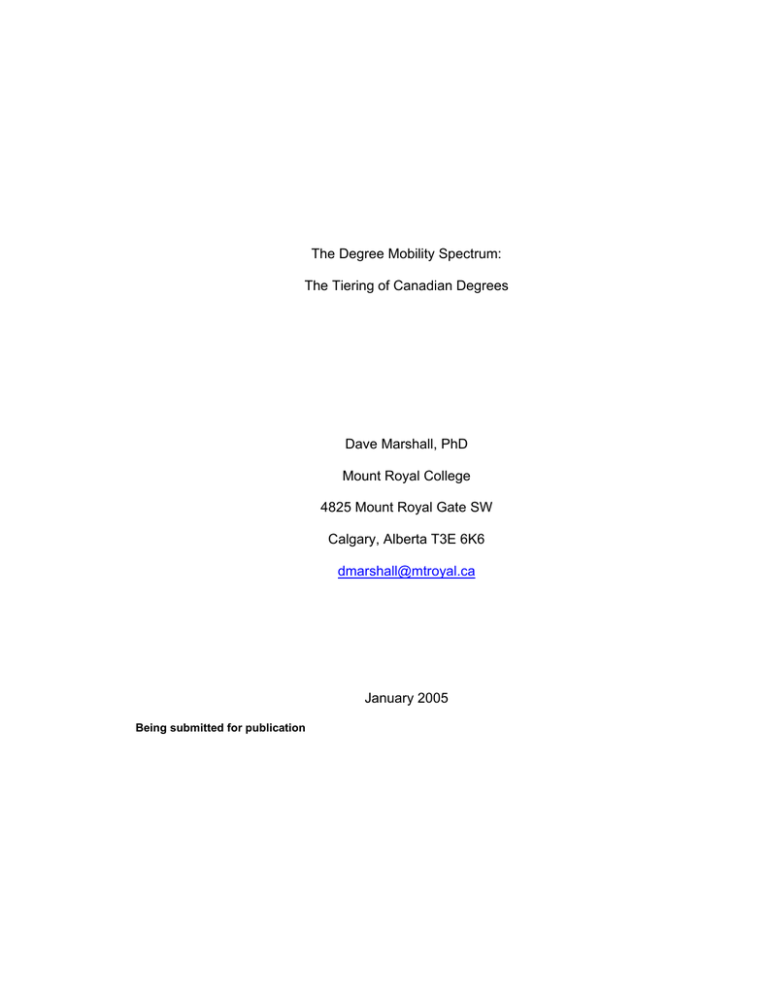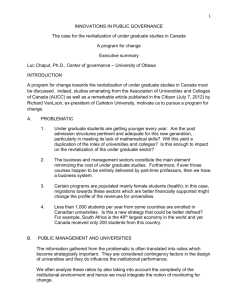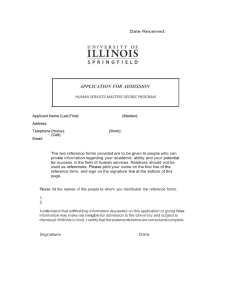The Degree Mobility Spectrum
advertisement

The Degree Mobility Spectrum: The Tiering of Canadian Degrees Dave Marshall, PhD Mount Royal College 4825 Mount Royal Gate SW Calgary, Alberta T3E 6K6 dmarshall@mtroyal.ca January 2005 Being submitted for publication Marshall 2 In Canada, the demand and continued growth in demand, for access to degrees, has been well documented. The participation rate in Canada in degree programs of the typical grade 9 cohorts has almost tripled over the past 30 years to over 20 percent. As reported in the Association of Universities and Colleges of Canada (AUCC) Trends in Higher Education (2002), we will need upwards of 100,000 new degree places in the next decade to meet the demand for participation in degree-level study.1 Our response in Canada to this dramatic increase in demand has been the same as it would in any supply-demand environment; we have tried to increase the supply. We have accomplished this by increasing capacity at traditional universities. Ontario alone has added 30,000 new first-year university places since 2001. We have added new universities (five in the last 15 years -- none in the previous 20). We have been innovative in system use to add capacity (for example, delivery of the two year university transfer programs in community colleges in British Columbia and Alberta). We have approved non-traditional delivery of traditional degrees (faith-based institutions, distance delivery institutions, private institutions). We have implemented other types of degrees (applied, technology). Alberta now allows (community) colleges to apply to offer full, foundational baccalaureate degrees. In general, there is now such a proliferation of degree types and sources that it is difficult for the consumer (student or employer) to sort out the value or meaning of the credential. The United States has always had a wide array of institutions and degrees. Consequently, the value of an American degree has always been more related to the institution than the label. Historically, this has not been the case in Canada, as only Canadian universities reviewed by a national association and given provincial legislative approval were able to offer degrees. This is 1 Association of Universities and Colleges of Canada (2002). Trends in Higher Education. (Ottawa: AUCC, 2002) Marshall 3 no longer the case. A changing degree environment has led to a change in the meaning and perhaps value of the Canadian degree.2 DEGREE MOBILITY From the perspective of the degree holder, the value of the credential is its usefulness in setting the degree holder apart from other individuals. The proliferation of new degrees has diluted this “sorting” effect of the degree credential. For the student, the issue becomes the uncertainty regarding the “mobility” value of their credential. Degree mobility gives the degree holder the flexibility to pursue further study or to obtain and change jobs or careers. That is, the more immediate access the credential gives to higher levels of study (graduate and professional schools), the higher its mobility value. Similarly the more access the credential gives to a combination of initial employment, employment change or advancement, the higher the mobility value. The least “mobile” degrees are general degrees offered in a non-university environment. In between degrees, like College applied degrees, while excellent initial workplace credentials, may not provide as good a base for future career changes. In the absence of any researchbased evidence, a degree’s mobility is largely speculative. Despite the wide variation in types of applied degrees, some applied degrees in Alberta in professional areas (Policy Studies, Criminal Justice, Interior Design,) are showing mobility characteristics similar to the University level credential. The newness of the applied degree credential in Ontario does not permit any experiential data to back up the assumption that this is a good workplace credential, but has 2 Dave Marshall, “Degree Accreditation in Canada,” The Canadian Journal of Higher Education, XXXIV – 2, 2004, pages 69-96. Marshall 4 lesser value for further study. As the (community) college-delivered foundational (B.A., B.Sc.) degree does not yet exist, its value is even more speculative. Even in the area of immediate employment, current data suggests very little difference between the values of any Canadian credential in providing employment within 6 months of graduation.3 Other than relying on rumour, speculation, media rankings, or institutional marketing mantras, the student consumer has little data to rely on in choosing the experience of one degree over another. Further, much of the data regarding the new credentials will take years to unfold. There is one aspect of this spectrum that is both verifiable and significant to the student; the effect upon future study mobility which comes with membership of the credential-delivering institution in the AUCC. AUCC MEMBERSHIP AND DEGREE MOBILITY Canada has no national accreditation process for either degrees or degree granting institutions.4 Some provinces are developing or have developed degree-quality assessment processes, but there is currently no national accreditation process for degree-granting institutions. This has not been needed in the past since there was at least a tacit recognition that degrees were only granted by provincially recognized universities. Since these 3 See Government of Ontario website re Performance Indicators for Ontario Colleges and Universities http://www.searchontario.gov.on.ca/cgibin/edu/format_sr.pl?query=Performance+Indicators+for+Ontario+Colleges+and+Universities&offset=0&collection=50800edutcu&la nguage=en&submit=Go. 4 Ibid. Dave Marshall and Judy Eifert. Marshall 5 “universities” were members of AUCC, membership in AUCC became the default “accreditation” process for accepted Canadian degrees. Since many of the institutions now offering or planning to offer the new degrees are not eligible (and not likely to become eligible) to become members of AUCC, it is important to know if these degrees will provide access to the graduate and professional schools at universities across the country. In order to explore this question, a letter was sent in the fall of 2003 to the presidents of a sampling of Anglophone Canadian universities with a significant proportion of their enrolments in graduate programs, asking for their admission policies regarding degree holders from institutions that are either “non-university” or “non-AUCC”. The question asked was simple: “If an existing (community) college offers foundational (B.A. or B.Sc.) degrees, what would be the eligibility of these students for admission to graduate or professional school at your institution?”5 In an attempt to achieve a 100% response rate, an email follow up was sent in the spring of 2004. In some cases institutions were asked for policy clarification. Since the purpose of the exercise was to get a snapshot of graduate admission policies in Canada rather than provide data on any one institution, the responses are provided in the aggregate. The analysis includes anonymous reference to individual responses, and the list of institutions is identified in Table 1. 5 Letter from Dave Marshall to Presidents of a sampling of Anglophone Canadian universities, November 24, 2003. Please refer to Table 1 for participating universities. Marshall 6 TABLE 1 Question: If an existing (community) college was to offer foundational (B.A. or B.Sc.) degrees, what would be the eligibility of these students for admission to graduate or professional school? Institution Brock University, Carlton University, Concordia University, Dalhousie University, McMaster University, McGill University, Memorial University of Newfoundland, Queen’s University, Ryerson University, Simon Fraser, University, Trent University, University of British Columbia, University of Guelph, University of Manitoba, University of Northern British Columbia, University of Ottawa, University of Regina, University of Saskatchewan, University of Waterloo, University of Western Ontario, Wilfrid Laurier University, University of Windsor, York University Only graduates from AUCC – membered institutions eligible for admission Graduates from AUCC-membered institutions are automatically eligible, and given first consideration; others considered on a case-by-case basis Non-AUCC graduates unlikely to gain admission; graduates from AUCC-membered institutions are likely, but not automatically. eligible Any graduate from a provincially approved degree institution is considered eligible 7 12 4 0 AUCC MEMBERSHIP AND ELIGIBILITY Responses to the initial letter indicated that admission policies for graduates from “nonuniversity” Canadian institutions initially fell into three distinct categories: (1) universities that consider only AUCC member institution graduates for admission, (2) those that consider AUCC- Marshall 7 institution graduates as automatically eligible and graduates of other institutions on a case-bycase basis, and (3) those that consider graduates from any provincially approved degree program. Queen’s University in Kingston has been the most public example of the first category. While this has been institutional practice for some time, the Queen’s Senate passed a motion at its January 22, 2004 meeting limiting access to Queen’s degrees to AUCC-institution graduates.6 While no other institution indicated that this was senate policy, seven of the sample surveyed indicated that this was their practice. Two institutions indicated initially that they considered all graduates from any degree program eligible for their graduate and professional programs. However, one institution’s comment that AUCC institution graduates were not automatically eligible prompted some further investigation of this practice. Investigation showed, in both instances, this practice was not to address the existence of other types of degrees in Canada, but the concern that not all AUCC member institution degrees should be considered equally eligible. One institution commented that they do not “automatically admit students with bachelor’s degrees from universities with ‘open’ admissions.” Another said, “We generally would not accept a degree from a non-AUCC member, but that is not to say that we will always accept degrees from institutions that are members at face value.” These clarifications of policy and practice gave rise to a fourth category, of “no non-AUCC member graduates, but not necessarily AUCC-member graduates.” Four institutions ultimately fell under that category. One institution clarified their admission policy as follows: 6 At its January 22, 2004 meeting, the Queen’s University Senate passed the following policy statement: “To satisfy the basis of admission requirements to any degree program at Queen’s, academic credentials obtained from a Canadian institution must be from an institution that is a member of the Association of Universities and Colleges of Canada (AUCC).” See http://www.queensu.ca/secretariat/senate/Jan2204/SCAD_CDNUniversitiesJan04.pdf for further information. Marshall 8 “…all graduate admissions are done on a case-by-case basis. There is no automatic eligibility. AUCC membership and/or provincial approval would not prevent a program from ruling an applicant ineligible because their actual degree program was not seen as adequate preparation …. [However,] … it would be highly unlikely that we would consider admission of a student coming from a Canadian institution that was not accepted for membership in AUCC. This does not imply, however, that membership in AUCC would guarantee eligibility.” Consequently, no university could be reported as giving equal consideration to both AUCC and non-AUCC/non-university graduates. The largest number (12) of institutions fell under a third category whereby they consider AUCC member graduates as automatically eligible and all others are considered on a case-bycase basis. These institutions are most likely to consider current graduates of Ontario’s, Alberta’s and British Columbia’s applied degrees for admission to graduate schools with high program affinity. For example, institutions such as Mount Royal College in Alberta report some success for graduates from its professionally oriented applied degrees such as Criminal Justice in gaining admission to graduate and professional (law) schools. They also report that these successes are “negotiated” one student and one program at a time. Similarly, many of the faith based, non-AUCC institutions have developed institution-to-institution articulations to ensure that their graduates have access to further study. This would be consistent with the admission practices of this category of the sample in this study. The following three excerpts from institutional responses reflect the admission policies of institutions in this category. (i) “…all applicants must have earned a ‘four-year Bachelor’s degree or recognized academic equivalent from an accredited institution’ to be considered for admission to Marshall 9 graduate study. Since Canada does not have a true institutional accreditation, we utilize the AUCC guidelines to define an ‘accredited’ Canadian university…” (ii) “In general, a student who is a graduate of an AUCC-member institution would automatically be considered for admission to a graduate program. Graduates from institutions that are not members of AUCC would be considered only on an individual basis.” (iii) “We typically only recognize degrees from AUCC members in Canada. Depending on the program that the applicant wishes to pursue, however, we would take a look at applicants on a case-by-case basis…” ANALYSIS AND DISCUSSION There are a number of factors affecting the development of Canadian university admission policies for non-AUCC member graduates. The new applicant environment: One large institution replied that the question was a good one, but since they do not receive many non-AUCC member applicants, they have yet to work out a specific policy in this regard. Indeed, as little as a decade ago, this would not have been a concern for any Canadian university as almost every Canadian applicant would have been from an AUCC-member institution. Currently, most institutions appear to be responding to the development of applied degrees and the increase in faith-based (non-AUCC member) degrees. The development of non-AUCC member foundational degrees (Alberta) may force many institutions to examine and make more explicit their policies regarding applicants from non-AUCC member institutions. Marshall 10 Provincial policies and practices: The issue of “non-AUCC” degrees garners more concern in some provinces than others. Specifically, universities in Ontario, Alberta and British Columbia are dealing with their own provincial approval of such degrees. Alberta universities have provided relatively clear responses regarding the eligibility of applied degrees from Alberta colleges, essentially declaring them ineligible unless specifically negotiated otherwise. In Ontario, (through the Council of Ontario Universities) all universities have agreed upon a statement of eligibility for graduates of non-AUCC institutions to Ontario universities that reflects on the sum category of requirements.7 Universities in Alberta, British Columbia and Ontario are likely to respond more expediently to the changes in the degree-granting environment. Other provinces will start to follow as they start to receive non-university applicants from these provinces. Professional requirements: As much of the increased demand for degrees is due to changes in various professions, the admission policies to various professional schools are constrained by these policies. Currently, a number of professions (teaching, nursing, accounting, and engineering) tie accreditation to degrees from AUCC-member institutions and tie institutional/faculty accreditation to admission policies that limit admission to AUCC-member graduates. 7 This COU memo on applied degrees and admission into second-entry, graduate and professional programs was first released in May 2002, amended in March 2004 and re-released in June 2004. It is named after David Marshall, the former President of Nipissing University and former Chair of the COU Standing Committee on Relationships with Other Postsecondary Institutions (1996-2003) and Bonnie Patterson, President of Trent University and current Committee Chair. It may be viewed at http://www.cou.on.ca/content/objects/BR_Applied_Degrees_paper.pdf. Marshall 11 Other institutional level factors: There are a number of other factors that institutions have identified that might affect the eligibility of graduates from non-AUCC institutions. • The increasing volume of applicants for both graduate and professional schools will lead institutions to become more selective and look for more ways to triage the larger applicant pool. • The degree of affinity between an undergraduate program and its graduate counterpart is an increasingly important factor. For example, since some applied degrees have been designed as workplace credentials, they have no graduate program counterpart. • The recognition of a degree by the closest AUCC-member institution could be an eligibility factor for a degree in the absence of AUCC membership for the institution. • The institutional track record in providing university-level education could affect the eligibility of degree holders. Eligibility vs. Admission: It became clear in examining the “Category 2” responses that institutions were making an important distinction between eligibility and admission. A number of universities were willing to declare that holders of non-AUCC member degrees would be eligible (on a case-by-case basis), but being admitted on the basis of that eligibility was another matter. One of the reasons for this is that most admission decisions are made at the department or faculty level and consequently, while institutional policy may indicate “eligibility”, departmental level decisions on admission can reflect a different reality. Marshall 12 CONCLUSIONS AND OBSERVATIONS While the existence of a well-defined spectrum of value of various degrees in Canada is not yet proven, a degree divide is clearly present. Baccalaureate degrees that are offered by institutions accepted as “universities” will clearly provide more mobility to further education for the degree holder than would baccalaureates from “non-university” institutions. In Canada today, it is apparent that membership in AUCC defines the boundary between these two categories of degree-granting institutions. This is understandable since AUCC’s membership criteria simply reflects the commonly, and internationally, accepted defining characteristics of a university. If it is assumed that the university environment is necessary to provide the appropriate value to the baccalaureate credential, then this “degree divide” is understandable. The implications for students, employers, governments and degree granting institutions are considerable. For students, it is becoming increasingly important to consider first the particular value of a degree, and the ability of that degree to deliver that value. For example, most of the newer applied degrees are workplace focused, while the traditional B.A. or B.Sc. is focused more on providing a foundation for further study or training. As the survey reported in this paper suggests, if mobility to further study is of concern, then it is becoming increasingly necessary to look beyond the label of a degree to the type of institution delivering the credential. For employers, the introduction of workplace-focused degrees such as applied degrees will continue to be a welcome innovation. This will be especially true if these degrees represent higher levels of learning and not simply a different label. Some of the applied degrees, Marshall 13 especially those in professional areas, are bridging the world between preparation for the workplace and further study. This particular study, however, began as an exercise to help one college consider its options as a degree-granting institution. In this regard the message is clear. Unless institutions can meet the requirements to be defined as a university-level institution, then the graduates of these degrees will have limited mobility. Finally, the growing degree divide described in this report suggests a scenario whereby it may be years after the students graduate before they fully appreciate the difference between the values of different types of credentials. Consequently, it is incumbent on institutions and governments to make it clear to applicants the mandate, focus and mobility value of degree credentials wherever they are offered. Marshall 14 References Association of Universities and Colleges of Canada, Trends in Higher Education. Ottawa: AUCC, 2002. Government of Ontario, “Performance Indicators for Ontario Colleges and Universities.” [Available Online Government of Ontario [Cited December 2004]. Available from http://www.searchontario.gov.on.ca/cgibin/edu/format_sr.pl?query=Performance+Indicators+for+Ontario+Colleges+and+Univer sities&offset=0&collection=50800edutcu&language=en&submit=Go Marshall, David, “Degree Accreditation in Canada.” The Canadian Journal of Higher Education, XXXIV – 2 (2004) : 69-96. Marshall, David, Letter to Sampling of Anglophone Canadian Universities, 23 November 2003. Marshall, D. and B. Patterson, “Marshall-Patterson memorandum on Applied Degrees & Admission into Second-Entry, Graduate and Professional Programs.” [Available Online Council of Ontario Universities [Cited December, 2004]. Available from http://www.cou.on.ca/content/objects/BR_Applied_Degrees_paper.pdf Queen’s University Senate, [Available Online Queen’s University [Cited December 2004]. Available from http://www.cou.on.ca/content/objects/BR_Applied_Degrees_paper.pdf.



